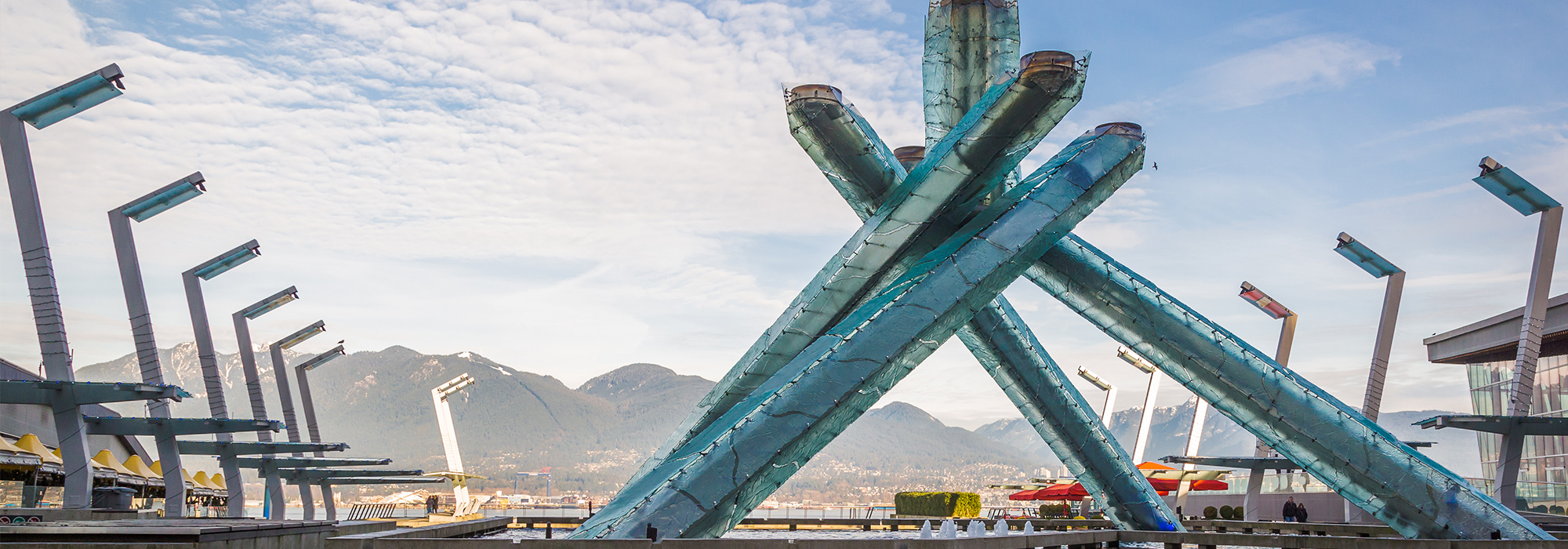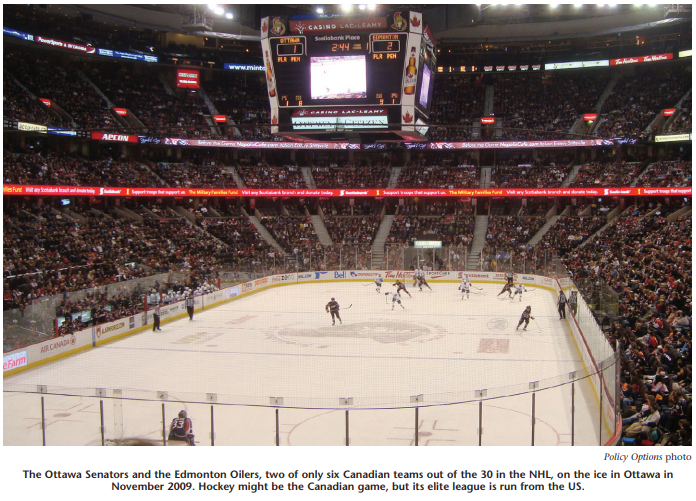
As the 2010 Vancouver Olympics fast approach, it is worth considering that, since Confederation, Canada’s national institutions — among them, Parliament, the country’s schools and universities, and, yes, even Canadian sport — have had to continuously wrestle with two capital challenges: first, how to build from east to west, or west to east (and north, of course), across the country’s vast geography; and second, how, if at all, to project beyond Canada’s borders. Both challenges are explained, if not anticipated, in the oft-neglected second recital (paragraph) of the preamble to the Constitution Act, 1867, which reads that the Canadian federation would “conduce to the welfare of the provinces and promote the interests of the British Empire.”
The first challenge is quite evident. That Canada should “conduce to the welfare of the provinces” speaks to an existential challenge that is known to all big federations — the United States, Russia, India — with heterogeneous populations and important regional (or “provincial”) dynamics: that is, the struggle against powerful and often chaotic centrifugal forces in order to build coherent, pan-country institutions that unite or bind, with varying intensity, citizens in common identity, culture and indeed collective ambition.
The second challenge — that of projecting internationally — is less intuitive. A country’s institutions may carry peculiar extraterritorial weight by dint of that country’s geopolitical importance or the sheer political or cultural attractiveness of those same institutions: that is, their susceptibility to conscious or unconscious emulation by other countries. Or, in a very related sense, a country may be able to project international influence or prestige by means of strategy: that is, the conscientious development and alignment of national means or assets and the national will for the precise purposes of such international projection. Countries like the United Kingdom, France, Russia and the United States, among others, have all at one time or another in their histories been such countries — geopolitically important, politically and culturally attractive (to different sets of countries) and, to be sure, highly strategic. That Canada, for its part, was made to “promote the interests of the British Empire” speaks, however, to the plain fact that Canada was never made, constitutionally speaking, to be able to project any independent weight whatever beyond its immediate borders — that is, but for the mediation of Great Britain. And, notwithstanding the verity that the Canadian state has since acquired all the formal trappings of constitutional independence, that it was at its genesis bereft of geopolitical heft, political-cultural prestige and strategic capacity is a brute fact that has patently conditioned the essential “intra-border” gravity of its institutions to this day.
Canadian sport, as mentioned, is just such an institution. To be clear, one could just as easily choose Canadian high culture or the purer arts (the visual arts, music, theatre, dance) as a representative institution — just in case the invocation of sport begets the common instinctual retort: What about the arts? But we choose sport not only because it is an institution to which precious little serious policy commentary is devoted in Canada, but also because it, far more than, say, the sciences, institutions of learning and formal institutions of governance, is an extreme example of the said two cardinal challenges at play. With very few exceptions, Canada has been exceedingly hard pressed to build bona fide, “thick” institutions of sport across the totality of its populated territory. The cognate difficulty of projecting Canadian sport beyond Canadian borders is far more plain to the casual observer: in general terms, Canada has also been hard pressed to achieve substantial and sustained sporting success on the international stage — at the Olympics, in world championships and in other major, global sporting competitions.
With very few exceptions, Canada has been exceedingly hard pressed to build bona fide, “thick” institutions of sport across the totality of its populated territory. The cognate difficulty of projecting Canadian sport beyond Canadian borders is far more plain to the casual observer: in general terms, Canada has also been hard pressed to achieve substantial and sustained sporting success on the international stage — at the Olympics, in world championships and in other major, global sporting competitions.
Let us start with the first challenge. Apart from the Canadian Football League, Canada has not a single proper elite sports league. In none of the world’s principal team sports — hockey, soccer, basketball, baseball, volleyball, rugby, field hockey, handball, lacrosse, cricket — has Canada a single bona fide senior, professional league that bridges the country. Even in its national and most popular sport, hockey, aside from the superb country-wide network of provincial and regional leagues at the junior level (the Canadian Hockey League), and notwithstanding sporadic efforts here and there to secure new Canadian franchises in the National Hockey League, there are only 6 Canadian teams of a total 30 in a professional league largely administered, at the strategic level, from the United States. (There are only 3 Canadian teams of a total 29 teams in the subordinate, American-run “farm league.”) Canadian “representation,” as it were, is even more paltry in the other team sports: one putatively Canadian team (putative because of the virtual absence of Canadian players) in each of the major American basketball and baseball leagues (and two teams in a largely American lacrosse league). An embryonic aspiration to similar such representation or participation in the National Football League grows slowly but surely.
To the reasonable outsider or foreign observer, all this would seem patently bizarre. For there is hardly a country in the world — small or large, insular or even bestridden by a much larger neighbour — that does not at least have a countrywide league in its national sport or sports. Scotland, at about one-tenth the population of England, has its own national soccer league — and an excellent one at that. (Indeed, Scotland has two national soccer leagues — two divisions, if you will.) Ukraine and Belarus, politically and culturally outflanked by Russia, each have serious soccer leagues. (Russia, a large, complex federation like Canada, of course, also has a very serious soccer league — with several divisions — among many other elite sports leagues.) Finland and Sweden each have serious hockey leagues — as well as soccer leagues, of course. Australia, another physically large — albeit slightly less complex — federation, has some six national sports leagues.
Granted, there are different species of national sporting associations and national tournaments in Canada, but the near total absence of national leagues (to be sure, for men and women alike), far from being of negligible moment, means, in perhaps the simplest terms, that individual Canadians and Canadian cities, towns and communities are deprived of one of the chief vectors from which other countries around the world profit to create a meaningful national cultural agora — a common cultural activity outside of politics through which the passions of the citizenry are channelled. Canada’s national or east-west “cultural discourse,” as it were, is greatly impoverished for this absence. In nearly all of the sports, and for nearly all Canadian cities and towns, there is manifestly no hometown team for which to cheer, no sincere intercity or inter-town sporting rivalries to animate the national spirits, and no common national (team) championship and trophy for which to strive — and to celebrate. In turn, from the perspective of the Canadian athlete, there is, in virtually all cases, no national league in which to ply one’s craft, no local Canadian team for which to play, no hometown fans to entertain. Indeed, every talented young Canadian basketball, soccer player or volleyball player — male or female — is by his or her mid-teens invariably confronted with the brute reality that, outside of participation on the national or Olympic team (a subject to which we shortly turn), the prospects for highlevel épanouissement in one’s sport are close to nil. University sport is an option (in both Canada and the United States), as is, for the most exceptional, recruitment to an American or European professional league. (The majority of the National Hockey League’s players evidently remain Canadian.) Failing these, however, there is the far more travelled path of recreational sport or, in extremis, outright abandonment of the sport in question.
With the conspicuous exception of hockey, Canada’s capacity to export sporting excellence internationally — that is, to prevail with regularity (and indeed with deliberate design) in international competition — has also historically been, and unquestionably remains, pedestrian. This is true of individual and team sports in both the summer and winter seasons, although the national record of international achievement in the summer sports is evidently far poorer than that in the winter sports. Granted, Olympic gold medals, world championships and number one rankings will be won here and there, and, on occasion, a sporting genius like Donovan Bailey or Rick Nash will be produced, but by and large the nationa policy approach to sport is substantially invested in what one might call “heroic amateurism”: an international hero or two issues from the national fabric, but because the national sporting culture is decidedly amateur, such heroes will be exceedingly improbable, triumphing largely by virtue of their own striving, and very seldom as a direct result of a Canadian policy infrastructure that targets, intends and aligns national assets for sustained, predictable international winning.
This state of Canadian athletic achievement on the world scene is, as mentioned, anticipated in the constitutional makeup of the Canadian state. Where it exists, domestic — à la limite continental — sport is, as a general rule, privileged over international competition, and, in turn, the handful of Canadian “heroic amateurs” who do prevail abroad, in individual or team sport, are — living as they do outside of the “national” sports discourse — misunderstood, underappreciated and often scarcely known. Even in hockey, the deep Canadian success of which we take up later in this piece, achievement in the “national” league (the National Hockey League) is, again, as a general rule, more prized than in the world championships and, until quite recently, the Olympic Games. (Let us recall that, before the 2002 men’s Olympic hockey gold, Canada had not won a single men’s hockey gold medal since 1952. And prior to the 1990s, Canada had not won a single men’s world hockey championship since 1961.) The participation of Canada’s best players — typically in the NHL — in top international tournaments is to this day never fully assured, and, given the choice between competing in the Stanley Cup playoffs and the world championships for Team Canada, it is nearly always the former that is given preference. Even when the world hockey championships were held on Canadian soil — most recently in Quebec City in 2008, where Canada finished second to Russia — the irony that Sidney Crosby, arguably at present Canada’s best hockey player, was playing for the Stanley Cup with the Pittsburgh Penguins in lieu of representing his country among the nations was lost on the entire Canadian sports commentariat.
By contrast, in Europe, most starkly, but indeed on virtually every other continent, international competition decisively trumps domestic championships. Tensions between club and country are certainly not unknown, but it is generally considered countercultural for an athlete to play — voluntarily or through contractual obligation — for a local club at the expense of the national team in major international tournaments. Indeed, it is expressly prohibited by many national and international sporting bodies. One would therefore be extremely hard pressed to find, say, a Ronaldo, a Ronaldinho or, formerly, a Zidane or a Maradona — failing to represent his country in the soccer World Cup because of competing club or local commitments. Quite the contrary: victory in the World Cup is privileged at nearly all costs to more provincial seductions, and the prestige of national success is the decisive imperative.
In individual sports — tennis, track and field, gymnastics, cycling, swimming, skiing, speed-skating — with rare exceptions, Canadian athletes are hardly world-beaters. In the main, they are the products of a national culture and different (federal, provincial, even municipal) policy frameworks — well short of a proper sports “system” — that view sport as an uncontroversial subset of health or recreational policy. Athletic participation rates are privileged, as are various social indicators relating to individual “well-being” — all barometers that fundamentally militate against regular international sporting excellence. The “system” is, as a consequence, and in the main, desperately reliant on the raw talent (of which there is no empirical evidence of any peculiar shortage), sacrifice and indeed heroics of individual Canadian athletes. Different governments, private concerns and foundations will, to be sure, inject money here and there in support of these athletes, but such monies, while proffered with only good intentions, are typically unconnected to any sophisticated and credible strategy for sustained international success. In short, there is no proper national “system” or policy bulwark in place to ensure a high probability of winning for Canadian sportsmen and sportswomen.
Of course, in policy terms, Canadian sport (like general culture, contrary to the strong claims to the contrary from Quebec) is of mixed constitutional competence; both the federal government and the provinces have legitimate jurisdiction over it. In the famous Anti-Inflation Reference of 1975, Justice Beetz stated that subject matters of excessive diffuseness, such as inflation (or, say, the environment or indeed culture and sport), may not be constitutionally ascribed to a single level of government. In practical terms, however, it follows that, for sport policy, as with many of these mixed jurisdiction files, in the absence of robust federal involvement (or “institution building”), the centrifugal pull of the provinces — or the powerful jurisdictional gravity of what is constitutionally called “property and civil rights” — is significant.
In other words, the property and civil rights gravity of the provinces overwhelms the federal gravity of interprovincial and international concerns.
One would therefore be extremely hard pressed to find, say, a Ronaldo, Ronaldinho or, formerly, a Zidane or a Maradona — failing to represent his country in the soccer World Cup because of competing club or local commitments. Quite the contrary: victory in the World Cup is privileged at nearly all costs to more provincial seductions, and the prestige of national success is the decisive imperative.
More precisely, if the federal government fails to properly drive national policy in this area on a sustained basis, in recognition of the aforementioned two cardinal Canadian institutional dynamics, then Canadian sport becomes a function of a variegated cocktail of provincial (and municipal) health and recreation, education and cultural programs, as well as provincial amateur sport programs — and, of course, of the said amateur heroism of the athletes themselves. At best, the federal government will intervene muscularly with one or two provinces, as in the context of a one-off major event, such as the 2010 Vancouver Olympics, to inject a degree of stimulus into the national sports infrastructure. In the alternative, the federal government will involve itself in crafting sport policy, but only to a limited degree, and this based on a policy diagnostic and a remedial paradigm rooted in erroneous or facile presumptions about what makes for strong national institutions of sport (discussed immediately below) or excellence in sport (as with the above-mentioned idea — no less than an empirical absurdity — that world champions somehow organically emerge from an otherwise healthy, active population).
It stands to reason that east-west national sporting institutions in Canada, like any of Canada’s strongest national institutions, can arise only from proper building supported by conscientious strategy. Indeed, it is only through sophisticated national planning and appropriate alignment of the national means in support of strategic ends that bona fide pan-Canadian structures can be created. In the event, the strategic end of creating national sports leagues (as perhaps the most evident form of a national sporting institution), notwithstanding presumptions about Canada’s “smallness” or its sui generis market integration with the United States, requires federal policy leadership. This policy leadership would recognize both the functional import of such leagues in driving national culture — as in other countries — and, just as vitally, the centrality of the federal role in the building of institutions where purely commercial considerations and provincial dynamics alone are clearly inadequate for the job. In other words, while it is reasonably uncontroversial that private concerns would have to provide a substantial share of the investment for different teams in each of the leagues, and while the provincial and indeed municipal levels of government would need to support or incentivize such investment (for provincial and local ends, of course), it would seem equally uncontroversial that all this activity should occur in the context of a national policy framework driven by the federal government. (Appropriate federal-provincial division of labour and cooperation would necessarily form part of this national policy framework.) And the framework, to repeat, would be not for the oft-caricatured purposes of creating wealthy professional athletes or “white elephant” stadiums, but rather for building viable, pan-Canadian sports leagues (institutions) that bind the country’s vast segments in common pastime, and, just as signally, provide an outlet for Canadian athletes to perform their craft at a high level, and in Canada.
The link between such national leagues and the export of Canadian sporting excellence is nonnegligible — at least in respect of the team sports. Whether each league is of the highest world standard is of far less consequence than the essential fact that the league provides a Canadian base for the professional development of a critical mass of high-level Canadian athletes who either directly populate Canada’s various national teams or, in some cases, feed top-tier Canadians to more elite leagues in other countries — as in, say, soccer or baseball — whence Canadian national teams are in turn formed. The presumption, however, that elite foreign leagues alone, without the support of domestic leagues, are in and of themselves adequate for the purposes of building strong national sports programs is empirically erroneous. For the record suggests, broadly speaking, that the pool of athletes that countries outsource to other countries (foreign leagues) for purposes of national team development is insufficiently deep to sustain an elite national program over a material period of time. Where an elite foreign league, such as the English Premiership (soccer), the National Basketball Association or Major League Baseball exists, a Canadian league, assuming it comes, ab initio, with a lower standard of play, should, in policy terms, therefore be seen as a necessary complement for purposes of building internationally excellent national teams. However, the absence of such a fundamental complement, by extension of this logic, almost unexceptionally condemns Canadian national programs to mediocrity. (And, manifestly, this is the current state of affairs.)
For both individual and team sports, another key paradigmatic shift in our national policy treatment would be to professionalize the very development of elite athletes. This shift would be tantamount to a concession that simply investing, grosso modo, in athletes once they have already reached the age of senior competition (say, over 18 years of age) — and this principally to subsidize only their training regime at a fairly modest clip — is a cosmetic, unscientific formula that works at fundamental cross-purposes with any serious national aspiration for international sporting success. For just as the doctor or lawyer issues from many, many years of formal schooling (some 12 or 13 years before university, followed by seven or eight years in university, and more in certain cases), the elite athlete is the product of a long value chain of training or formation. And to the extent that we strategically interest ourselves in the development of this athlete only in the later, downstream stages of this chain, we necessarily defer to the said paradigm of the “heroic amateur.” We hope that a random pot-pourri of factors will yield elite specimens — age-eligible for competition, at which we may throw dollars — but we do precious little to precipitate or guarantee such an outcome.
All of this is patently at odds with the approaches of a good number of countries (Australia, Germany, Russia, China, among them) — all more successful than Canada, generally speaking, in international sporting competition — that have recognized that proper athletic development, as with the cultivation of the musical virtuosos, is no matter for the amateur. International competitiveness requires the establishment of bona fide national institutes of sport. (The famous Australian Institute of Sport, or the AIS, is perhaps our best model in this regard.) These institutes should be populated by properly remunerated elite coaches, trainers and sports scientists recruited from around the world; after all, if Canada is to become strong in a sport like soccer, it must lever international talent, just as other countries would look to Canada to improve their hockey bona fides. They should have world-class sports facilities and infrastructures. And, most importantly, their mandate should be to select, at reasonably early ages (depending on the sport in question), the most promising Canadian athletes from around the country for sustained, serious, “professionalized” development. These select athletes would evidently have robust academic curricula that they would have to follow in concert with their athletic preparation, but the essential point is that their athletic curricula, much like the academic, would be regulated by government — strategically with the aim of creating worldclass athletes in multiple sports.
Campuses of the institutes of sport would be stood up across Canada — with each campus focussing on a handful of sports, according to local comparative advantage. Scholarships would be offered to selected athletic candidates, and high standards of performance (athletic and academic) would be expected of recruits. Athletes could attend local campuses or move to out-of-province campuses to train in a particular sport. Granted, a good number of these recruits could, over time, prove to be unsuccessful in their chosen sport, in which case the proper goal would be for each individual athlete to emerge from the program as a literate, lettered, productive citizen. (We note the concept of the citizen-athlete.) However, a good number of these athletes may well emerge as successful international athletes (in some cases, true world-beaters) — no accidents at all, but the products of a sophisticated, world-class Canadian strategy or system of athletic development; in itself, a proper national institution.
Photo: Shutterstock










